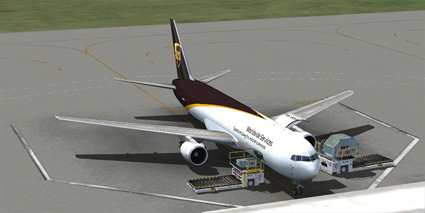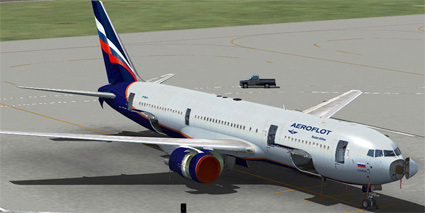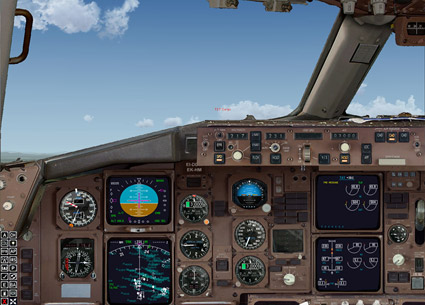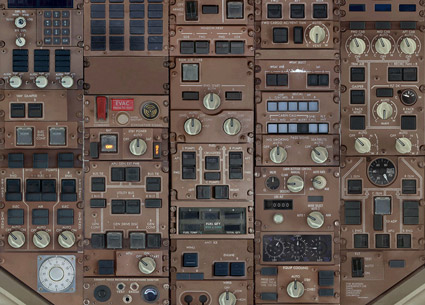Following on from my previous Captain Sim review of
their 727 for FSX, they have kindly given me a copy of their
newest ‘Pro Line’ product; the Boeing 767. The product is
available in several variants, but you must have the base
767-300 pack installed to be able to utilise the other add-on
packs. The add-on packs consist of:
• 767-200
• 767 Freighter
• KC-767 Tanker
• E-767 AWACS
This is a shrewd move by Captain Sim for them and the end consumer. If you want the extra variants you will need to pay to add them to your collection, which helps keeps Captain Sim in business, but it also keeps the cost down for the end user as you only have to buy what you want. I was surprised when I received my download links and I had been given the whole 767 range. Thank You! As with the 727 the email containing the download links was bounced into my spam folder, as I had an idea that this would happen I knew where to look. If you do purchase this add-on and do not receive your download links shortly after your order is processed, make sure to check in the spam folder.
History
The 767 is a twin-jet wide body airliner which can carry up to
375 passengers over a range of 6,590 nautical miles. The 767 was
conceived and designed in tandem with the 757, which means that
they share design features and flight decks. It was the first
Boeing wide body which could be flown without the need for a
flight engineer. The
airliner is used most often on medium and long haul routes,
common routes being between the USA to Europe. So far over
1,000 orders have been placed for the 767 with over 900 already
delivered, with the -300 and -300ER variants accounting for
almost two thirds of all orders.
The aircraft first flew in September 1981 and earlier
this year there were still over 850 aircraft still in service
with nearly 50 airlines.
For people based in Europe, if you have been on a charter
holiday to the Canaries there is a very good chance that you
will have flown on a 767.
 |
Installation
After downloading the files installation (as is more often than
not the case now) was quick and easy; you just need to make sure
that you install the base pack first. During the installation
process you will be prompted to enter you order number to verify
your copy. This verification is done over the internet and only
takes a few seconds. You will need to do this with each add-on
pack you install so keep the order number to hand. After
installation a new folder is added to you StartàPrograms menu which has the Aircraft Configuration
Editor (ACE) and links to the manuals. Follow this link and
download the PDF manuals before making your first flight. The
manual is split into 5 sub-manuals:
1. Users Manual – General overview of
each add-on pack – 46 pages
2. Aircraft & System¬ – Self
explanatory – 107 pages
3. Normal Procedures – Includes
checklists – 34 pages
4. Flight Characteristics and
Performance Data – Info such as reference speeds – 44 pages
5. Flight Management System –
Operation of the FMC – 99 pages
As you can see, no-one can accuse Captain Sim of not
providing enough documentation to help you learn how to operate
this aircraft. As with all Captain Sim products however, there
is no tutorial included as the information provided in the
manual is more than enough to get you going. I agree and
disagree with this policy as it does force you to read through
the manual, but I am a firm believer of learning through doing.
Although searching around the internet did provide me with a
short and long tutorial flight and several videos on YouTube
showing how to operate the aircraft. I wouldn’t advise printing
out all of the manuals, read them on screen and only print the
parts that you think you will need most often. As I am familiar
with the way high fidelity Boeing simulations work I ended up
only having to print out around 25 pages from the manual,
although this will differ from person to person.
I was surprised to see that there was no fuel planner
included. With an aircraft this complex I would have expected
the fuel planner to come as standard. Future update maybe?
What's Included?
• High quality visual models
• Unparalleled realism
• Extensive systems modelling
• 2 high resolution full screen 2D panels
• 40+ additional 2D panels
• High resolution liveries (14)
• Hundreds of custom animations
• Highly detailed VC
• Authentic sound set
• Repaint Kit
• Captain Sim Weather Radar (€9.99 if bought separately)
• Rotating dome (AWACS)
• Animated centre line unit, boom and receiver (KC-767)
• Plus much more
There aren’t as many liveries included as I was
expecting, however, this keeps the clutter on your hard-drive
down. Over time expect to see lots of third party repaints
available on FS download sites.
 Click image for full size view |
 Click image for full size view |
Take to the skies
If you just want to get up in the skies Captain Sim
have included a saved flight which already had the aircraft
engines running and ready for take-off (a cold and dark scenario
is also included). Just remember that you will need to change
the time and date settings of these flights as they are set to a
couple of years ago.
If you want to start from a cold and dark scenario,
always use the included cold and dark flight. It might take a
few more minutes messing around getting the time, date and
departure airport set up correctly but you will be starting the
aircraft from its proper cold and dark state. I have my own cold
and dark saved flight set as my default flight, but for this
aircraft I wasn’t able to get things running smoothly and some
of the warning messages wouldn’t go away. A few more minutes
preparation is well worth it in the long run. The first few
times I started from a cold and dark cockpit it took me quite a
while to get things working, after a few goes though I was
beginning to get more efficient at it. (TIP: Search on YouTube
for videos going through pre-flight, they are much easier to
remember than the manual). One problem I encountered during
pre-flight was loading the fuel; sometimes the left tank would
only stay at 100%, others it would let me enter what I wanted! A
fuel planner which you could load the fuel through would be
excellent here.
The FMC
Programming the FMC, once you know the procedure, is
quick and easy. I like the fact that Captain Sim have added in
the option of being able to load the FS flight plan that you
have created, rather than having to program each waypoint
individually. If you do still want to do this that option is
there. I found that loading the FS flight plan saved a lot of
time, but did lead to some problems when calculating the top of
descent points. This didn’t happen when I programmed the FMC
manually. Not a massive problem as it’s easy to program crossing
altitudes for the waypoints, and if you are flying using the
default ATC it will tell you when to descend anyway.
After entering the relevant information into the FMC
for departure, your V-Speeds are calculated for you, there are
some problems calculating the aircraft’s centre of gravity and
setting the take-off trim. It’s very much guess work until you
find the sweet spot. Getting the trim setting wrong will cause
you to climb like a rocket after take-off; not good for the
passengers in the back.
The FMC is the heart of aircraft such as the 767 and
correct understanding of how it operates is critical to making
the flight go smoothly. All the information you need is included
in the manual, reading this is a must to get the most out of the
aircraft. If you are using the FS ATC you will more than likely
never had to enter a hold or need to intercept a VOR radial
15miles from the VOR, but if you fly on-line you will. If you
plan to take this aircraft on-line make sure you know it inside
and out if you are flying into crowded airspace.
 Click image for full size view |
 Click image for full size view |
Cockpit
Captain Sim have shunned what is becoming the norm and
have provided both a 2D and 3D cockpit. I preferred flying from
the VC but did all my programming on the ground using the 2D
cockpit. Both cockpits are fantastic and it is possible to
program everything from the VC but some of the buttons were a
little difficult to read. Using the 2D pop-up panels is much
easier.
It doesn’t just stop with the flight deck; there are
several other views to take in during the flight. Various
positions in the cabin, galley, jump-seat etc.. which are all
nice pieces of eye-candy but I wouldn’t have complained if they
had been left out. You will spend 95% of the flight on the
flight deck, so I feel that all the extra internal views aren’t
needed.
Exterior Model
It’s fantastic. Nothing more to say on the subject
really. The edges of the aircraft are nice and smooth, the
animations are good and the included liveries are brilliant. To
be fair, if I was buying an add-on from a developer with a good
reputation, I would expect nothing less! I hope that the
included screenshots help to get across how good the exterior
model is.
Extras
If you are a simmer who likes to take in all the ramp
action pre-flight you are in for a treat. Open up the load
manager from the flight deck and you can select how much cargo
goes into each hold and then move the trucks forward and back
and load the cargo crates into the hold. Watching this from the
spot view was something very unique and really adds to the whole
flight experience. Remember to check the weights after loading
so that you get the right values entered into the FMC.
Alternatively, you don’t need to watch the animated loading
sequence if you don’t want to.
Flight Characteristics
I was expecting the aircraft to be a little sluggish in
response to control inputs, but it’s not. You won’t need to move
the controls much to get a significant response from the
aircraft, which makes it fantastic to hand fly. On most of my
flights I didn’t engage the auto-pilot until I had passed
through 10,000 feet. Select LNAV, VNAV and the FD prior to
take-off and follow the bars on the PFD. If you engage the
auto-pilot straight after take-off you are losing out big time.
At the other end of the scale, hand flying the approach and
landing is equally as easy and fun. Some of my touch-downs
weren’t as smooth as if the auto-pilot had made them, but they
were a lot more fun!

Performance
Performance, initially, was a mixed bag. During cruise
my frame rates were good, but down on the ground there were
nothing more than shocking. Even at an empty municipal airport
without any AI Aircraft, airport vehicles or cars etc... I was
struggling to get over 10fps. Flying into and out of Heathrow
even without AI was a no go area. Tweaking settings didn’t help
much either and it was becoming quite annoying that everything
was perfect until you attempted to land or take off, which
defeats the object of flying!
However, Captain Sim has listened to peoples complaints
and has issued a patch in the last few weeks which addresses
these issues and it has fixed them. My frame rates have
increased by over 50% at airports and I can now add some AI and
still keep things running nicely. I can’t help thinking that all
the extra VC views have had a negative impact on frame rates.
Whilst they are nice to look at once in a while, I would happily
trade them for a smooth flight.
![]() Verdict
Verdict
A Fantastic high fidelity airliner simulation from one of the best in the business.
| Pros | Cons |
| • Excellent representation of the 767 | • Performance can be mixed |
| • Thorough documentation | • No fuel planner |
| • Great exterior model | • Lack of tutorial |
| • 2D Cockpit + sub-panels included | • Fuel loading issue (sometimes) |
| • Excellent to hand fly |
Mutley's Hangar
Verdict 8.5/10
![]()
/Rob Scott

